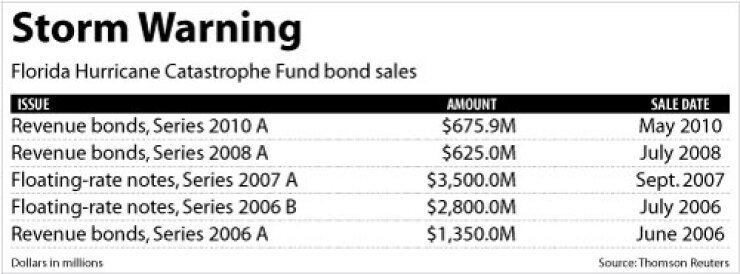
BRADENTON, Fla. — The Florida Hurricane Catastrophe Fund could issue up to $12 billion of bonds if needed to pay claims during this year’s hurricane season, according to estimates prepared by senior managers.
The so-called Cat Fund’s advisory board Tuesday certified that the bonding capacity is expected to be available during this year’s hurricane season, which runs June 1 though Nov. 30.
In addition to the bonding capacity, the state-run, nonprofit reinsurer also has $7.25 billion of liquid resources on hand to pay claims.
The bond capacity and cash on hand are expected to be enough to support its potential exposure to claims, which totals $18.5 billion.
Twice a year the board must affirm how much in claims it could legally be required to pay and how much of that could be raised through the sale of bonds to support the payment of claims.
The $12 billion is an average of available capacity in the bond market provided by the Cat Fund’s senior managers — Citi, Goldman, Sachs & Co., JPMorgan, and Barclays Capital Inc.
How much debt could actually be issued given volatility in the market and restrained investor demand depends on what the market will bear at the time, according to John Forney, managing director of public finance for Raymond James & Associates Inc., the fund’s financial adviser.
“We believe a reasonable estimate for the Cat Fund’s borrowing this year is about that $12 billion,” he said.
Forney said the agency’s liquidity does not include $3.5 billion of taxable floating-rate notes sold in 2007 that have a bullet maturity on Oct. 15, 2012. He recommended setting the proceeds aside to be used in the early part of next year’s storm season if necessary.
The Cat Fund also has $1.88 billion of tax-exempt bonds outstanding. They are rated AA-minus by Fitch Ratings, Aa3 by Moody’s Investors Service, and AA by Standard & Poor’s.
In related matters Tuesday, Cat Fund director Jack Nicholson told the board that it may be necessary to issue additional bonds to pay for claims from damages caused by four hurricanes that battered Florida in 2005.
Nicholson said the statute of limitations on filing claims related to the 2005 storms does not run out until June 1 and the Cat Fund has received new claims this year that currently exceed available bond proceeds by about $30 million.
An estimate on how much in additional bonding might be necessary to settle the claims is not yet available, he said.
So far, the fund has sold three tranches of tax-exempt bonds for 2005 claims: $676 million in May 2010, $1.35 billion in 2006, and $625 million in 2008.
It was hoped that the tranche sold last year would cover the final 2005 claims but the Cat Fund has experienced problems with the long statute of limitations and a large number of claims that have been reopened in recent years. The Florida Legislature passed a bill earlier this month shortening the statute of limitation for filing claims to three years.
The possibility of changing the name of the Cat Fund in order to attract more investors was discussed by the advisory board and underwriters’ representatives.
They also talked about implementing an annual financing program to provide liquidity in advance of a hurricane and to increase the name recognition of the agency.
The Cat Fund provides low-cost catastrophic reinsurance to Florida’s private property insurers and the state-run Citizens Property Insurance Corp.
The fund was created to help stabilize the property insurance market after Hurricane Andrew slammed South Florida in 1992 after which some private insurers became insolvent or stopped writing policies because of the risk.





